Guide to Moving Chess Pieces
Pdf version: Guide.pdf
Google Docs: Google Docs
Table of Contents
Introduction
Most people when they think of chess think of a complicated game with many rules. At first glance, it can be daunting, so making the first move is a challenge. This guide aims to explain the basics of chess - how the pieces move. After reading this, you should be able to pick up the pieces and make your first move!
Pieces
Before getting into how the pieces move, we have to first understand what the pieces are. They come in all sizes and shapes, but generally speaking, it is not too hard to distinguish one from another. The large number of pieces makes chess seem more complicated than games such as checkers, which have a very limited piece variety. This variety causes some players to lose interest, but it is exactly what makes the game so complex and interesting. Getting the names of the pieces and what they look like is a start and that’s how we will begin!
| Piece | Image | Piece | Image |
|---|---|---|---|
| Pawn |  |
Knight |  |
| Bishop |  |
Rook |  |
| Queen |  |
King |  |
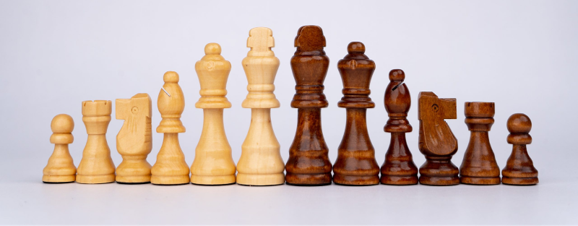
From left to right: Pawn, Rook, Knight, Bishop, Queen, King, King, Queen, Bishop, Knight, Rook, Pawn
Movement
Chess is a turn-based game in which each player makes exactly ONE legal move per turn. In one move, a player can choose to move a piece to an empty square (moving) or move a piece to a square occupied by an opponent’s piece (capturing). Each different piece has its own set of rules to follow for where it can move.
Pawn
The pawn is considered the weakest piece in chess. Each player starts with 8 of them.
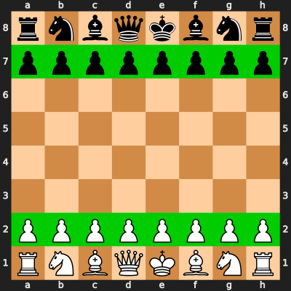
The highlighted pieces are pawns on their starting squares.
-
If the pawn has moved (it isn’t on the starting square), it can only move one space forward.
-
From their starting squares pawns are given the option to move one space forward OR two spaces forward.
-
If there is a piece on any square directly ahead of your pawn, your pawn is unable to move there.
-
There is a way for pawns to capture opposing pieces by moving diagonally one square forward to a square that is occupied by an opposing piece.
Example 1:
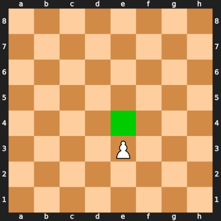
The green square indicates where the pawn can go. Since the pawn is not on the starting square, it can only move one space forward.
Example 2:
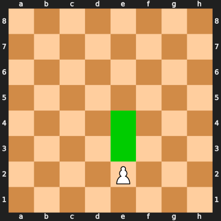
The green squares indicate where the pawn can go. Since the pawn is on the starting square, it can move either one OR two spaces forward.
Example 3:
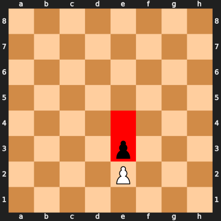
The red squares indicate where the pawn can NOT go. Since the black pawn is in the way, White’s pawn can not move!
Example 4:
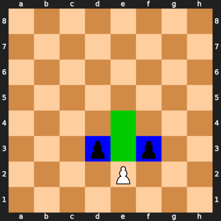
Like in Example 2, the pawn can move two squares since it’s on its starting square (indicated by the green squares). The blue squares indicate captures the white pawn can make.
If White captures the left pawn, the resulting position is:
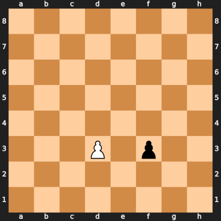
If White captures the right pawn, the resulting position is:
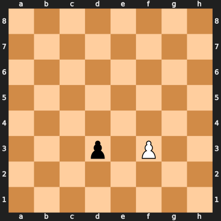
It is important to note that White is NOT required to capture on their turn.
The pawn can be thought of as a horse in a race. They look straight ahead (moving forward) and can see a little bit to the side (capturing) so they can stay focused on reaching the finish line. A horse’s goal in a race is to cross the finish line first and it may be rewarded with applause and perhaps a prize. But, where is the pawn’s finish line? What is the reward for crossing it?
Promotion: In chess, when the pawn reaches the other side of the board, it is able to be replaced with either a bishop, knight, rook, or Queen. That is, any piece besides the King and a pawn. So, for a pawn, the finish line is the other side of the board and the reward is promotion; however, it is quite a long journey that goes one move at a time.
Rook
The rook moves horizontally and vertically:
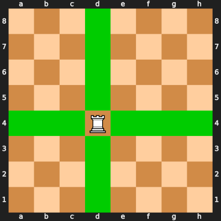
Green squares indicate where the rook can move
It also captures that way:
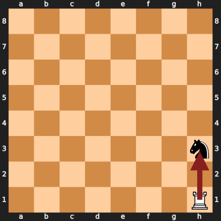
Rooks are incapable of jumping over pieces. That is to say that if there is any piece in its path, it can not go past that piece regardless of if it’s a friendly or opposing piece.
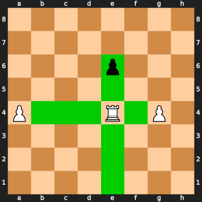
Green squares indicate where the rook can move
Bishop
The bishop moves diagonally. Because of the geometry of the board, that means that the bishop can only stay in one color.
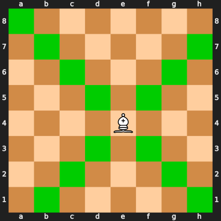
That’s why usually you want 2 bishops or the “bishop pair” to control both colors.
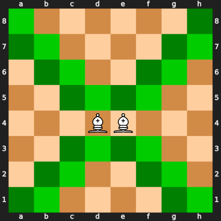
Bishops captures diagonally and can NOT move past pieces (similar to the rook):
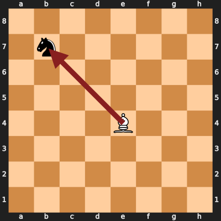
Queen
The Queen can move and capture diagonally and horizontally and vertically. It is considered the most powerful piece because it has the most range. It is basically the rook and bishop combined.
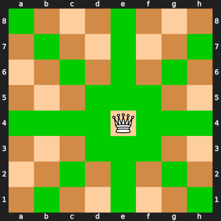
It follows the same rules as the rook and bishop with respect to moving over pieces - it can NOT.
King
The King is the most important piece in chess. This is because if you are put in a position where your King cannot escape capture then you lose the game!
- The King can move one square in every direction.
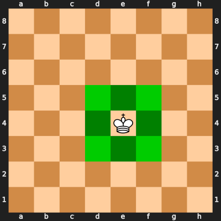
-
The King can NOT move to another square that is attacked by an enemy piece.
-
It can only capture undefended enemy pieces because if it were to capture a defended piece, then the King would be putting itself in danger (check) which is illegal.
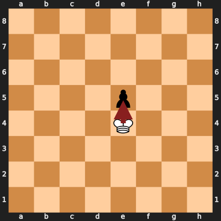
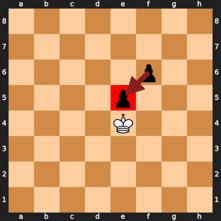
- Your King and the enemy King must always be more than 1 square apart otherwise this would violate rule 2.
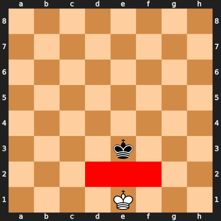
- The King can be “in check” (check is when the enemy piece is attacking your King) and you must deal with the check in some way. You cannot ignore it.
There are 3 ways to escape check:
-
Block the check with one of your own pieces (put a piece in the way of the attacker).
-
Take the piece that is checking.
-
Dodge the check by moving your King.
Castling
There is a rule that allows you to immediately give your King shelter which is called castling. In castling, you are allowed to move your King 2 squares to the side and then move the rook in the corner to the other side of the King.
Example 1:
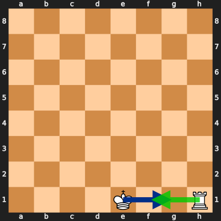
This is a case of kingside castling. The King moves 2 squares to g1 and the rook moves to the other side of the King to f1. The resulting position after castling looks like this:
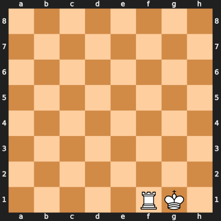
Example 2:
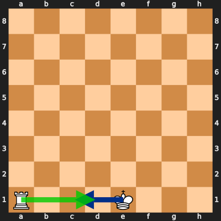
This is queenside castling. Just like before, the King moves 2 squares to c1 and then the rook moves to the otherside of the King to d1. The result of queenside castling is this:
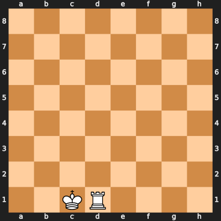
Certain conditions have to be fulfilled for you to be able to castle:
-
Castling must be the King’s first move. If you have moved the King before then it is illegal to castle.
-
Castling must also be the rook’s first move. If you have moved the rook on the kingside then you cannot castle kingside. If you have moved the rook on the Queen’s side then you cannot castle queenside.
-
There can not be any pieces between the King and the rook:
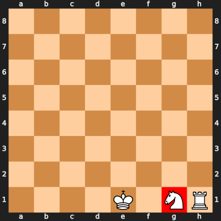
-
The King must not be in check or pass through check.
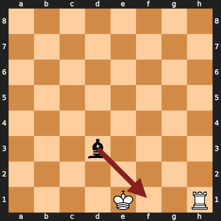
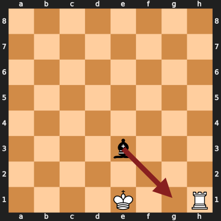
Knight
The knight moves in a L shape in every direction. The knight moves 2 squares and then 1 square left or right and it can move 1 square and then 2 squares left or right. Because of its abnormal movement, it can jump over pieces.
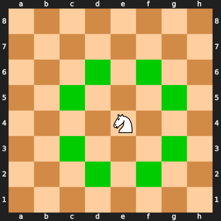
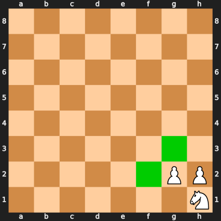
The knight can capture any enemy piece that is on a square that the knight can move to:
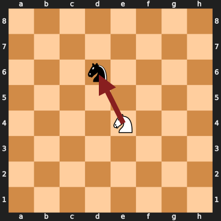
En Passant
“En Passant” is another capture method that the pawn has. The pawn can capture pawns right next to it if the other pawn uses the 2 move rule.
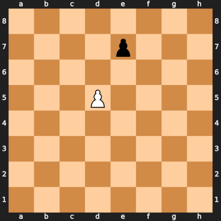
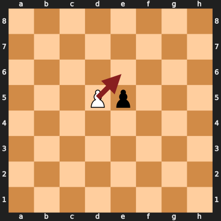
So, looking at the diagram we have a pawn on d5 and a pawn on e7 that just used its 2 move ability to move to e5. Since the pawn is right next to our pawn and it just used the 2 move rule, we are allowed to take it and the resulting position is:
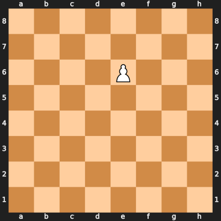
Conclusion
Now that you know how to move the pieces, you are ready to start your first game of chess… except maybe you don’t know how the pieces are set up at the beginning of the game! The starting configuration is like this:

A way to remember it is, “white square on the right.” That is, the bottom right corner (from your perspective) should be on the right. A common mistake people make in setting up the board is also the order of the Queen and King. A way to remember it is the Queen ALWAYS goes on its own color.
Okay now you’re ready to play! Remember, your goal is to put your opponent’s King in such a way that they can’t move AND you are attacking it! If you can do that it’s what we call checkmate.
Thank you for reading and we hope you could find some use out of this!
Authors:
Alan Bui Savio Joseph Benher